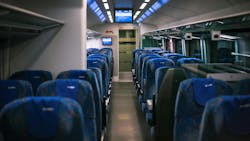Op-Ed: We don’t need flying cars – we just need transit that works
When considering the daily commute, there’s a stark disconnect between the futuristic visions of some tech companies—promising flying cars and autonomous shuttles—and the reality everyday transit riders currently face. While mobility innovators are thinking ahead to what will make for a flashier, more luxurious transit experience, commuters are demanding attainable upgrades to make their daily travels a little less frustrating. Affordability, reliability and accessibility are all top of mind, which is why the immediate future of urban mobility must focus on proven, practical solutions that center the realistic needs of present riders.
The newest survey from Diffusion, fielded by Censuswide, shows that reliability and efficiency (42%), decongestion (27%) and accessibility (26%) are the top requests from transit riders over a flying car. Riders are far less interested in high-tech innovations that don’t solve core issues of cost and reliability. Data highlights that expanding and improving the reliability of buses, trains and other mass transit options was a top factor for improvement over the next decade (47%), demonstrating that urban dwellers are exacerbated by congestion, unreliability and social inequity. These findings underscore a clear mandate: Cities must address the fundamentals before chasing lofty dreams filled with unproven technologies.
Necessary investments to benefit the majority
Investments in futuristic technology often come at the expense of improvements that could immediately benefit millions. Examples include cities spending millions on pilot programs for autonomous vehicles with limited utility while existing bus routes remain underfunded and lacking reliability. While flying taxis, hyperloops and other futuristic modes of transportation sound great, the majority of urban residents struggle with delays, crowded buses and inaccessible stations that need fixing.
Frequent, on-time transit reduces the need for car trips, saves riders time and makes cities more livable; it was also the number one response when it came to transportation improvements commuters would like to see. In fact, less than one-fifth (17%) of respondents described their city’s transportation and mobility solutions as “highly efficient” and the same number described it as “struggling” and “inefficient.” The mismatch between flashy promises and the basic needs of riders reveals a troubling gap between what’s marketed and what’s actually needed.
Investments in urban mobility should be guided by practical, evidence-backed priorities that help commuters reach their destination affordably, safely and seamlessly. On-demand electric scooters and bikes, for example, give people flexible options for first- and last-mile connections. Expanding protected bike lanes and improving cycling infrastructure make these modes safer and more appealing for a wider range of people, including those who might otherwise drive. Additionally, better integration between rideshare services and transit schedules can fill gaps in areas without robust transit.
The need for advanced technology
That’s not to say that innovative technology doesn’t have its place. Forward-thinking technology can absolutely improve transit outcomes when used to enhance, not replace, existing systems. For example, real-time bus tracking reduces uncertainty for riders, contactless fare payment systems improve boarding speeds and convenience and integrated trip-planning apps can help riders combine buses, trains, bikeshare and walking to navigate cities more easily. However, these technologies are most effective when layered onto robust, dependable networks—not as stand-alone gimmicks promising to revolutionize mobility without addressing core needs.
The road to effective mobility solutions
Ultimately, cities should measure progress by how well they meet the needs of residents, not by how futuristic they appear in marketing videos. A truly innovative, tech-savvy and accessible city is one where everyone—regardless of income, age or ability—can move affordably and efficiently. Focusing on proven, people-centered improvements over time is what creates more sustainable and vibrant communities versus futuristic technologies that cater to a privileged few.
The data is clear: people want transit systems that are affordable, accessible and dependable. Cities have the power to deliver these improvements now, and the technology is out there. Prioritizing the real needs of riders over flashy concepts will build cities that work better for everyone – today and in the future.
About the Author

Tory Patrick
Vice President of Diffusion
Tory Patrick is a vice president at Diffusion PR, where she is responsible for positioning and executing PR and media strategy for her clients across a broad range of industries. She has a passion for elevating brands through thoughtful and impactful campaigns that drive results and business leads.
